The story of Navy PBY Catalina rescue planes from Bureau of Naval Personnel Information Bulletin, NAVPERS, July 1944:
The Catalina Kids
Their Specialty Is Snatching Downed Aviators from Under the Japs’ NosesThirty-eight flyers rescued in a 35-day period.
That’s the record in the South Pacific for the Navy crewmen who fly the big Catalina flying boats, nicknamed the “Twin-Engined Angels” because they have proved to be angels of mercy to so many flyers shot down on the vast Pacific. Almost daily the Catalinas and their daring crews snatch aviators from under the very noses of the Japs. Official records show that 161 flying personnel were rescued by the “Cat Kids” from 1 January to 15 August 1943.
When the Catalinas first came to the South Pacific, fighter pilots were inclined to scoff at the comparatively awkward flying boat, and dubbed it “Dumbo, the Flying Elephant.” All that is changed now.
These PBYs patrol hundreds of miles of ocean. In most rescues they have been searching for some particular downed airman but, due to the vigilance of the crews, there have been several instances where they sighted and picked up pilots who had been floating about in life rafts for many days.
PBY operations in the Solomons are not new, but their effectiveness has been brought into the limelight with the intense warfare in the skies above Rabaul. Originally brought to the Guadalcanal-Tulagi area in December, 1942, for patrol work, the Catalina crews were pressed into service almost immediately for rescue work. Somewhere in the rear area they remained on the alert for a call. When the call came it probably meant a dangerous mission, but also a chance to save a life—perhaps several lives if it were a bomber crew.
A tip from a New Zealand pilot, returning from Rabaul, led to the rescue of 1st Lt. Glen E. Hart, a P-38 pilot. He had been adrift off New Ireland for a week, but clung to the hope of rescue by a PBY. Too weak to paddle, he drifted for days. Then on the seventh day he saw the “Cat Kids” coming for him. Asked what his reaction was to the sight of the PBY coming alongside him, Lieutenant Hart said:
“The PBY was my only hope. When it arrived, I just broke down and cried.”
As Lieutenant Hart was being rescued, a Marine pilot, Maj. Robert G. Owen, was in difficulty over Rabaul, a few miles away. He had just downed his seventh Zero when his own plane was hit and set afire. Major Owen’s first reaction was to bail out. He even started to crawl out onto the wing, but changed his mind when he saw he was directly over the city.
Getting back into his burning plane, he decided to try to get past Cape St. George, New Ireland. By some miracle the fire went out. On the horizon he saw the PBY that had picked up Lieutenant Hart. When his plane motor started to conk out, Major Owens radioed the PBY to stand by for a water landing, and he soon was picked up and on his way back to the base.
From a mercenary standpoint, the rescue of 38 flyers in slightly over a month has meant a saving of around $1,000,000 to the Navy. It is estimated that the training of a pilot, even before he has seen combat, costs $27,000, while the cost of training an enlisted man runs into sizable figures.
Of paramount importance, however, is the morale uplift for pilots. They know the Catalinas’ rescue record, and they know that if they are shot down the Catalina crews will risk their necks to save them.
Catalinas often have gone in under fire from shore batteries to rescue pilots. In this work they usually have the support of fighter escorts who fight off enemy interference until the rescue is affected. Fundamentally, the Catalina is not a combat plane although it is capable of defending itself from fighter planes.
One PBY, piloted by Lt. (jg.) Leon H. Freeman, USN, rescued a B-25 crew one mile off the tip of Cape St. George. During the rescue operations, shore batteries fired on the plane, and about 100 rounds of 20-mm. fire landed in an area from 10 to 50 feet away from the flying boat. Another Catalina, piloted by Lieut. Robert D. Oakley Jr., USNR, landed in St. George Channel, almost at Rabaul, to rescue a New Zealand flight sergeant.
Many a Jap plane in the future will be shot down because the Catalinas are seeing to it that Allied airmen are living to fight another day.











Brave pilots. Saved a lot of lives.
“One PBY, piloted by Lt. (jg.) Leon H. Freeman, USN, rescued a B-25 crew one mile off the tip of Cape St. George. During the rescue operations, shore batteries fired on the plane, and about 100 rounds of 20-mm. fire landed in an area from 10 to 50 feet away from the flying boat. ”
My dad, Jim Hall, was First Mechanic on this plane. The pilot and crew received citations.
Yes, Brave men all.